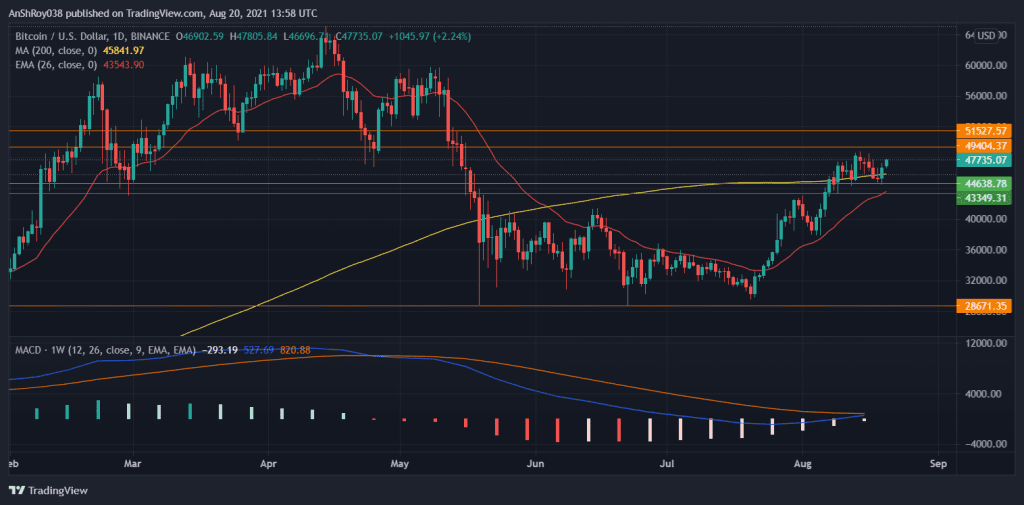
Key Takeaways:
- China’s president plans to redistribute wealth to tackle economic inequality.
- The PRC plans to impose additional tax on the super-wealthy.
- Bitcoin would become a haven for Chinese billionaires to safeguard their wealth.
NEW DELHI (CoinChapter.com) — People’s Republic of China’s President Xi Jinping proposed an outline for wealth distribution that has put Chinese billionaires on notice. In a meeting with the ruling party’s central financial and economic affairs commission, the President asserted the government should regulate excessively high incomes.
The Chinese president’s bid to redistribute wealth comes when the wealthiest 1% of the Chinese people hold 31% of the country’s income. However, China’s actions may act as a boost for Bitcoin. With the wealthiest being a target, Bitcoin becomes a logical hedge against the coming regulations, as the cryptocurrency is out of government purview.
Meanwhile, Bitcoin prices rebounded from the $45,000 price level to breach above $47,000 on August 19. BTC’s weekly MACD also moves upwards to cross above its signal line, indicating a bullish crossover.
China’s Billionaire Crackdown
The Chinese ruling party aims to end poverty and build a moderately prosperous society. However, the economic disparity in the country widened during the pandemic. Small businesses and poor workers took the worst hit of Covid-19. At the same time, the number of new ultra-rich ballooned 50% compared to 2019.
In its efforts to reduce poverty, Beijing is now targeting the upper end of the income spectrum. The Chinese Communist Party’s Central Financial and Economic Affairs Commission stated it would pursue a “common prosperity agenda” by regulating excessively high incomes. Additionally, it would encourage high-income groups to return more to society.
Also Read: Bitcoin (BTC) could top $100,000 early next year, supported by bullish indicators.
The latest goal comes amid Beijing’s bid to control the country’s largest private firms, including technology and education. The combined net worth of two dozen Chinese tech billionaires dropped by 16% since June 2021.
Stocks on the Shanghai exchange fell, after peaking in February, due to regulatory crackdowns and penalties on industries due to tighter environmental laws. Economists believe taxes on property and inheritance may be in the works. Carol Liao, an economist at Pimco Asia Ltd., believes capital gains taxes are also an option.
Bitcoin To The Rescue
Facing the government crackdown, the uber-wealthy are looking at options to safeguard their wealth. As such, Bitcoin becomes the obvious option. Being a cryptocurrency, it stands outside government purview, making it safe from Beijing’s plans.
Bitcoin also acts as an independent hedge, unaffected by either Yuan or USD currency flows. Although the Chinese government banned banks from using BTC and evicted miners, Chinese investors favor the flagship crypto. In addition, Chinese exchanges moved their operations offshore to escape licensing issues on the mainland.
Also Read: Why do the US dollar and Bitcoin keep gaining global momentum
Other exchanges started offering the option to buy BTC using US dollar-linked stablecoin USDT.
Another reason why the Chinese wealthy might opt for Bitcoin is that BTC is free from capital control. In detail, capital control means measures taken by a regulatory body to control the flow of foreign capital in and out of the domestic economy. With Bitcoin’s universal accessibility, capital control policies have no effect.
Moreover, currencies might depreciate over time, but Bitcoin’s limited supply and increasing demand ensure that BTC prices keep moving up. Thus, although Bitcoin may seem volatile, when viewed in the long-term range, BTC provides profits. For example, after May 19’s crash, BTC prices were at a low of $28,848. Comparing May 19, 2021’s low to May 19, 2020’s high of $9,960, BTC registered a gain of 189%.
In addition, the Yuan is weakening. Beijing intentionally weakens its currency, as a stronger Yuan would increase the prices of Chinese products, thereby reducing exports. Historically, Bitcoin prices have gone up whenever Yuan has weakened. While the Yuan-Bitcoin correlation may be termed coincidental, there are enough instances of BTC going up when Yuan has gone down to make it a psychologically important indicator.
As such, Chinese billionaires are likely to hoard their capital in Bitcoins, adding bullish tailwinds to Bitcoin’s sails.
Bitcoin Price Chart
BTC broke above $48,000 on August 13, before market corrections pulled back prices. Nevertheless, the digital currency rebounded from support at $44,638 on August 19. Friday saw Bitcoin back above the $47,000 price level.

Further support for BTC lies at $43,439.31, near the 26-Day (Red) Exponential Moving Average trendline.
On the other hand, any upward movement will face resistance at $49,404. If bulls breach this resistance, the next target would be $51,527.
Interestingly, BTC’s weekly MACD is close to charting a bullish crossover. The MACD line (difference between 12-week and 26-week EMA) moves upwards towards the MACD signal line (9-week EMA of MACD). When the MACD line moves above its signal line, momentum is considered bullish.
At the time of writing, BTC was trading at $47,778, up 2.38% on the day.


